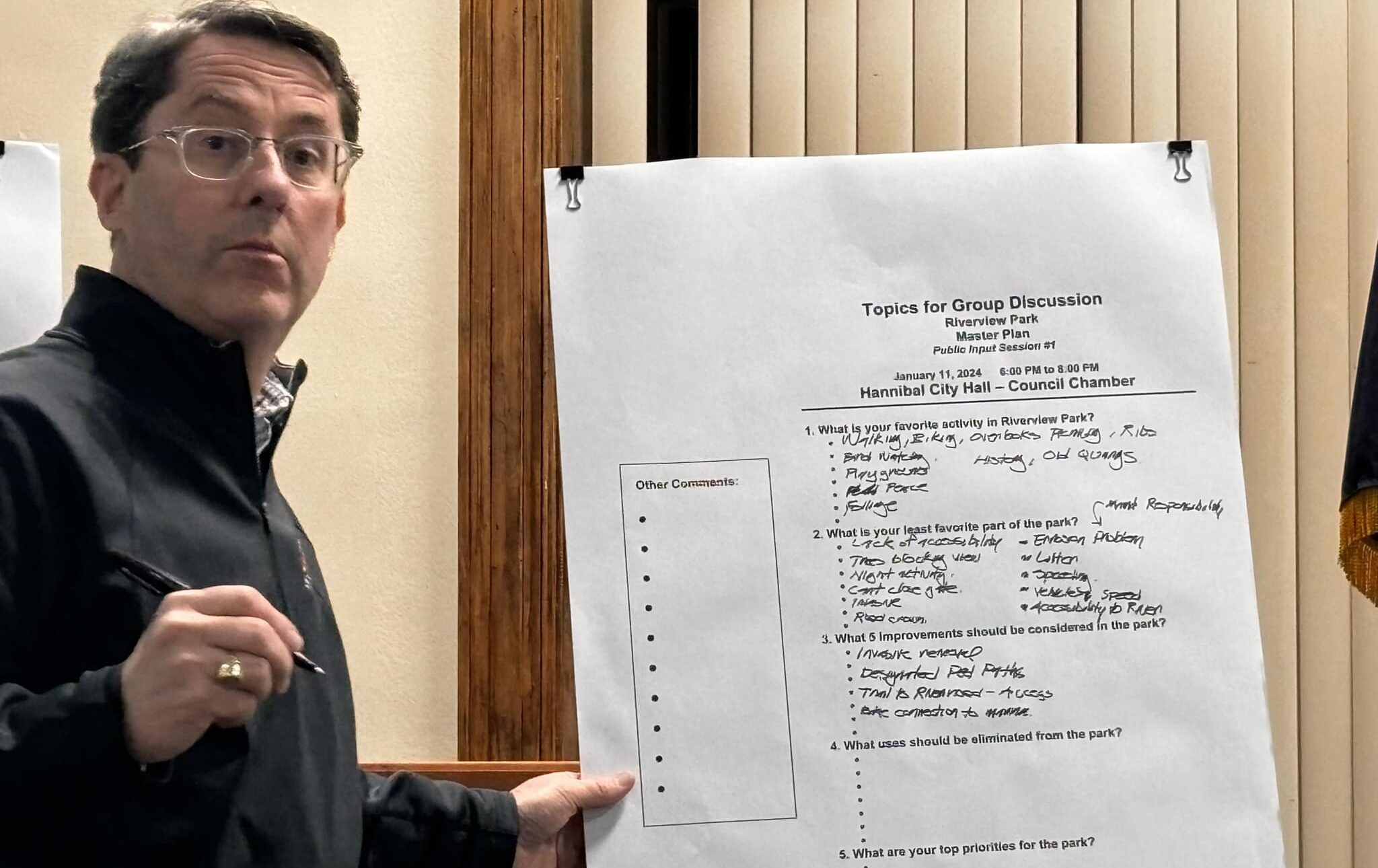Hannibal community members offer thoughts on Riverview Park master plan at public forum

HANNIBAL, Mo. — Hannibal community members chimed in on the Riverview Park Master Plan on Thursday night at a public input session.
Andrew Franke, principal and professional landscape architect at Planning Design Studio, fielded public suggestions and comments to five questions he posed to the group. Also with him was Martin Meyer, architect lead at Hutchinson Engineering, and Andy Dorian, Central Services director for the City of Hannibal.
A variety of answers were given when Franke asked for everyone’s favorite things about Riverview Park.
“Hiking!” was immediately called out.
“The playground for the grandkids,” came next from the crowd.
From birdwatching, foliage and photography to a rich history of the park and more, it was clear many people love Riverview Park.
Although when Franke asked for least favorite things, the list quickly became longer than the list of favorites. Safety was a recurring concern. Many were concerned about the safety of hiking alone and being in the park at night. Others reported drivers speeding through the park and the danger of pedestrians and cars sharing the same roads.
“One of our major concerns as railroad employees was hikers coming down that trail and crossing the track,” one person said. “If there are no trains coming, that’s not really an issue, as long as they lifted their feet up when crossing the rails, but so many times there were people coming down to try to rush in front of the train.”
An overpass was suggested as a possible solution.
Issues of crumbling walls on overlooks were mentioned, along with erosion and invasive plants and trees. The current maintenance of the park was listed.
Before taking group comments and questions, Franke gave a presentation about what his group has found while analyzing the 465-acre park.
The park was gifted to Hannibal citizens in 1909 by William Pettibone, who hired Ossian Simonds. Simonds was a landscape architect who did a blend of civil engineering, architecture and gardening in the early 20th century when the profession was just emerging.
“Pettibone was very progressive in that he hired a landscape architect to design this,” Franke said.
Franke showed a picture of “Frisbee Hill” at Riverview, which he called a “hallmark of landscape architecture.”
Simonds, a founding member of the American Society of Landscape Architects in 1899, favored the prairie-style landscape design. Franke said Riverview Park is one of the “few known examples of his vision,” although he said the current entrance of the park does not likely reflect Simonds’ vision.
Franke explained that the overhead wires detract from the main entrance, which was not the original entrance. He also said views are dominated by the water plant, and the concrete paving for the plant dominates the entry experience.
“Signage is there, but it’s not quite adequate. It doesn’t really give you the best first impression of the park. That’s kind of something we’re going to be thinking about as we develop this master plan,” he said.
He said the group found the one-way streets and road signs confusing. It also expressed concern about the shared vehicle and pedestrian roads. Franke said the reason the roads and walking areas are not well-defined is because when the park was designed, there were not many cars in the area.
Walking trails will be an area of focus, especially in the north and south areas of the park which currently have none. The group will look at three old quarry sites in the park which suffer significant washouts. A priority will be to connect the walking trails to downtown.
Another theme of the meeting was the park’s vegetation. Franke said 630 trees were counted just in the areas of the park that are mowed and maintained. More than 40 percent of those trees are sugar maples, and Franke said they throw too much shade on other trees.
Franke’s presentation reported the distribution of trees should be:
- Largest proportion of the inventoried tree population (approximately 40%) should be young trees, while the smallest proportion (approximately 10%) should be mature trees.
- More tree plantings to beef up the younger end of the spectrum.
- Try to preserve mature trees as much as possible.
- In general, the size class/age distribution is fairly decent.
The master plan will take about nine months to complete and will create a playbook for the future of the park. Improvements are to be completed over the next one to 10 years. It also will provide a map for future fundraising efforts.
One attendee mentioned a master plan already is in place from the 1990s but only about 10 percent of it was implemented. Dorian agreed that plan wasn’t used by those in office at the time, but he assured the group that a new master plan would be followed.
“The key to this is to not come up with things that are so crazy that will never fly and let’s design things that are attainable,” he said.
Dorian said part of what will bring the master plan together is the dedication of citizens and specifically the group Friends of Riverview Park, who first initiated the master plan.
Franke said he was encouraged that the meeting was so well attended on a night with predicted snow.
“It’s great to see everybody come out and it’s a surprise. Sometimes we have these meetings and nobody shows up,” he said. “I think this is a good indication of the interest everyone has and the love they have for the park.”
Franke said no more public forums are planned for the park. The group will continue to seek public input from online surveys on the Hannibal Parks and Recreation Riverview Park page.
Miss Clipping Out Stories to Save for Later?
Click the Purchase Story button below to order a print of this story. We will print it for you on matte photo paper to keep forever.

